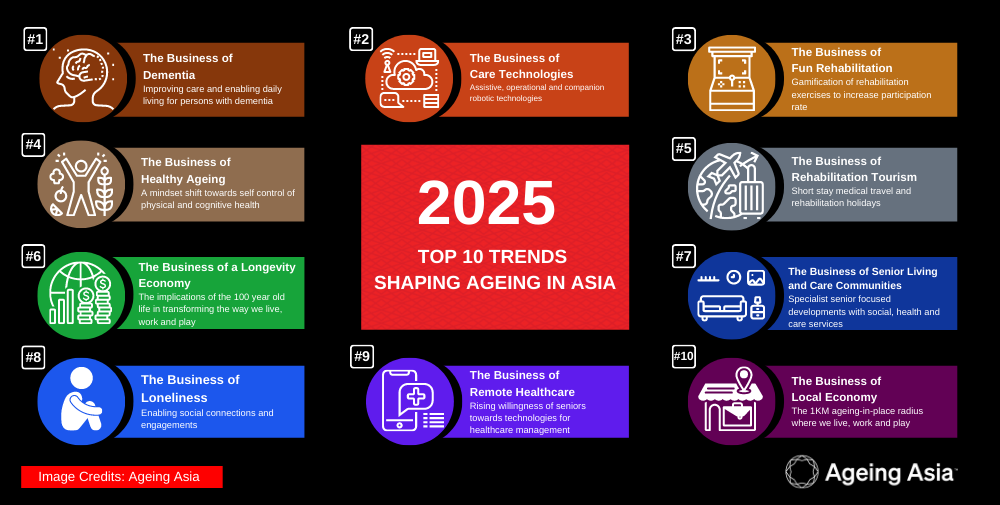The 4th Asia Pacific Silver Economy Business Opportunities Report (2020 edition) that looks at the projected ageing market and trends by 2025 identifies the top 10 trends shaping ageing in Asia. A new market defined by how seniors will live, work and play.
The baby boomer (born between 1944 to 1964) population is rapidly emerging as the new Cool Ager demographic. We are only just awakening to the opportunities driven by the 1.2 billion seniors in Asia Pacific. The lens on the world of ageing is now embracing the journey and celebrating the grey. The new 60+ population is overthrowing all preconceived notions of what old should look and feel like; what seniors want and what the definition of old is all about.
Today’s 60+ generation is ageing differently from previous generations. Baby boomers are typically a generation that worked hard, saved well, are self-sufficient and drive change in the demographics. They are typically better educated, more independent, are healthier and travelled abroad more than previous generations.
As they age, their attitudes, behaviours, wants, likes and dislikes will determine the success or failure of businesses that want to capture a piece of this projected lucrative US$4.56 trillion* silver market opportunity .
According to the 4th Asia Pacific Silver Economy Business Opportunities Report (2020 edition) that was launched in August last year, 10 key trends/opportunities were identified for the Asia Pacific’s ageing demographic

The World Health Organization (WHO) predicts the 60+ population will nearly double by 2050 from 12 percent to 22 percent. Globally, brands from the United States to Japan to Europe, and now Asia, are actively trailblazing silver demographic opportunities with product line extensions, personalisation strategies, technology innovations and niche sector marketing. According to research highlighted by the International Longevity Centre United Kingdom, happiness and age is possibly co-related, and one’s happiness level could increase with age. The trend is U-shaped with peaks at youth, moderate happiness in the years from 20s to 40s, rising again to a new peak at 74 years old. We see this as a positive indication of people ageing with more financial and family commitment freedom in later years. The silver economy potential will continue to bring rising awareness to the business of ageing for global brands and marketers seeking new market opportunities.
In Asia, traditional notions of filial piety where parents and children live together in multi-generation houses are undergoing a transformative change. Whilst baby boomer parents may choose to live and care for their parents, many may not envision their children doing the same. The baby boomers are more empowered and engaged, with many preferring to make their own decisions about where they want to live, how they want to spend their money. They may also actively plan how to age as they get frail, and even how they want to leave this world with advance care planning and early estate planning. Having had the responsibility of caring for their parents, top of mind for many baby boomers would be how to avoid being a burden to their children and families as they age.
For business that want to tap into the booming silver maket, there are potentially two major baby boomer market segments to capture: the rising middle to higher income baby boomers and the high net worth baby boomers. With a renewed expectation for higher standards of living by the baby boomers, demands and needs of the ‘new young’ could extend beyond healthcare, overlapping into every sector of the economy: Real estate, tourism, transportation, wellness, beauty, food, technology and finance.
